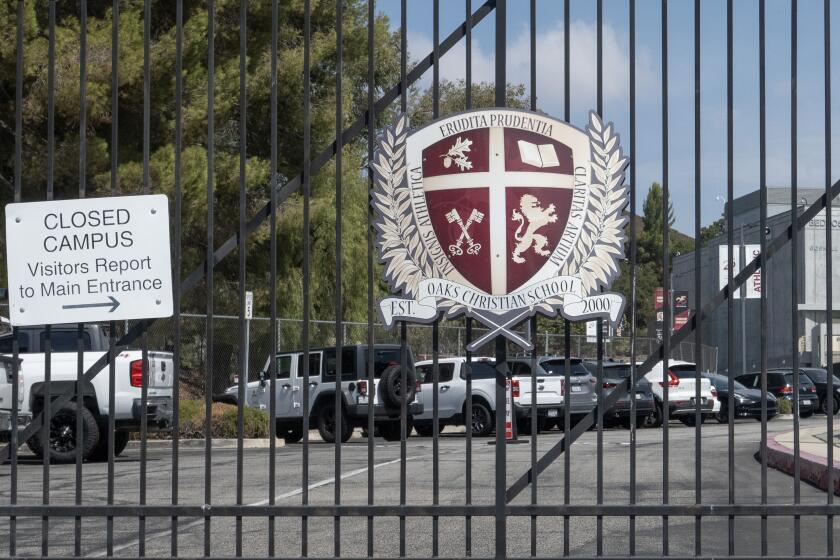Though Shaky, Young Condor Off on First Flight
With hidden video cameras monitoring her every move and 15 anxious observers silently applauding each flap of her wings, a nervous 9-month-old Andean condor took off on her maiden flight Saturday, awkwardly soaring 350-feet down a steep canyon on a journey researchers hope will lead to the eventual release of California’s endangered condors.
The bird was one of three freed in stormy weather this weekend at Hopper Mountain National Wildlife Refuge in Ventura County, about 50 miles northwest of Los Angeles, officials from the federal condor release program said Monday. The other two birds, scared by their new-found freedom and uneasy about their limited aerial experience, restricted their flights to small circles in the rocks above the release site.
The birds are expected to stay near the wildlife refuge for the next month while they become acclimated to the outdoors and continue to be provided food by bird researchers. Later, officials said, the condors will be released for good in the Los Padres National Forest.
Test Program
The program, run by the U.S. Fish and Wildlife Service and aided by condor researchers from the Los Angeles and San Diego zoos, is designed to test methods biologists would use in releasing highly endangered California condors into the wild in the 1990s. All 28 of the California species, the largest birds in North America, are in zoos in Los Angeles and San Diego.
“It was pretty exciting, for her and for us,” said Michael Wallace, field supervisor for the condor release program and curator for birds at the Los Angeles Zoo. “When we first released them they just froze at the door for about 15 minutes until one of the birds went out and began jumping up and down and flapping her wings. Then she launched herself right off the cliff.”
It took nearly two days for the condor, dubbed Y1 and the oldest of the trio, to make it back up the canyon and rejoin the other birds. But Wallace said it was a short rendezvous. Not long after she arrived Monday, she went back to the edge of the cliff, unveiled her 9 1/2-foot wingspan and launched herself into the air again.
The three carrion-eating vultures are the first of up to 17 Andean condors that will be freed by the end of 1989 to test the survivability of condors in the wild. The three birds released over the weekend were taken to the release site in Ventura County in August and have been living in a net-covered enclosure since then.
‘Very Immature’
“Eventually all of the birds will leave but right now they are very immature, just getting used to their first flights,” said Oliver Pattee, a project leader with the U.S. Fish and Wildlife Service. “They are pretty weak still and they get tired very quickly. And since they’re not used to it, flying scares them.”
Wallace said the birds are also having difficulty adjusting to their new surroundings. When the oldest condor finally landed after her flight into the canyon, he said she sunk down into the chaparral because the thick brush was unable to sustain her 20-pound weight.
“She was having a hell of a time trying to gain her balance,” Wallace said. “And all of a sudden she was in the middle of nowhere and she didn’t know where to go. She ended up spending the night there. In fact, we all spent the night there.”
Four more condors, which are in the nearby Sespe Condor Sanctuary, are expected to be released in late January, Wallace said.
Cost of $20 Million
The massive effort to save the California condors has already cost more than $20 million, according to federal officials. The Andean condor release experiment will cost about $440,000.
Although only 28 of the once widespread California condors remain, 1,000 to 2,000 Andean condors exist in the wilds of South America. Thousands of California condors once flew free, but four of the last five breeding pairs vanished by 1985.
The following year, the U.S. Fish and Wildlife Service decided to round up the last six wild birds to help prevent their demise. The first condor chick bred in captivity hatched April 29 of this year and is doing well at the San Diego Wild Animal Park.
More to Read
Sign up for Essential California
The most important California stories and recommendations in your inbox every morning.
You may occasionally receive promotional content from the Los Angeles Times.










